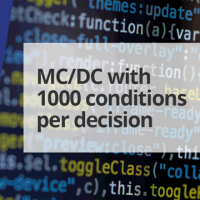So, assuming that you've run all of your tests and you've achieved 100% MC/DC. Does that mean that the compiler has correctly compiled your code?
In short, the answer is no.
Let's see an example to illustrate a case where 100% MC/DC fails to expose a compiler fault.
Imagine that some optimization rule is wrong in your version of the compiler and functions that start with an or operation accidentally get xor operations instead. Can you still achieve 100% MC/DC for software generated with this compiler without exposing the fault? It turns out that you can!
As an example, assume that the expression you are testing is (written in Ada):
x := y or z;
In C the same expression could be written as:
x = (y!=0) | (z!=0);
Note that we've used a bitwise or in this case, as the logical or (||) has slightly different behavior, namely the second expression isn't evaluated if the first expression is true, which is different to the Ada code's behavior.
We can achieve 100% MC/DC for the above code with the following test cases:
- Input:
y = True, z = False; Output:x = True - Input:
y = False, z = True; Output:x = True - Input:
y = False, z = False; Output:x = False
In this situation, Testcase 1 and Testcase 3 together achieve the MC/DC of condition y, and Testcase 2 and Testcase 3 achieve MC/DC of condition z.
If the compiler generates code where x is defined as y xor z, executing the test cases defined above would give you exactly the results you expect. However, if you happened to rerun the tests with both y and z as True (not required for MC/DC), the behavior of the code would be incorrect (you would expect a True result and would actually get a False result). Clearly, MC/DC is not a good way to argue that object code is correctly generated.

 Rapita System Announces New Distribution Partnership with COONTEC
Rapita System Announces New Distribution Partnership with COONTEC
 Rapita partners with Asterios Technologies to deliver solutions in multicore certification
Rapita partners with Asterios Technologies to deliver solutions in multicore certification
 SAIF Autonomy to use RVS to verify their groundbreaking AI platform
SAIF Autonomy to use RVS to verify their groundbreaking AI platform
 RVS gets a new timing analysis engine
RVS gets a new timing analysis engine
 How to measure stack usage through stack painting with RapiTest
How to measure stack usage through stack painting with RapiTest
 What does AMACC Rev B mean for multicore certification?
What does AMACC Rev B mean for multicore certification?
 How emulation can reduce avionics verification costs: Sim68020
How emulation can reduce avionics verification costs: Sim68020
 How to achieve multicore DO-178C certification with Rapita Systems
How to achieve multicore DO-178C certification with Rapita Systems
 How to achieve DO-178C certification with Rapita Systems
How to achieve DO-178C certification with Rapita Systems
 Certifying Unmanned Aircraft Systems
Certifying Unmanned Aircraft Systems
 DO-278A Guidance: Introduction to RTCA DO-278 approval
DO-278A Guidance: Introduction to RTCA DO-278 approval
 Avionics Certification Q&A: CERT TALK (with Consunova and Visure)
Avionics Certification Q&A: CERT TALK (with Consunova and Visure)


















